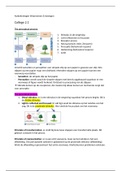[STEPS 1 AND 2] Definition and creation of a mortgage
A mortgage is an interest in land given as security for a loan. X is the
mortgagee/lender/creditor, who has lent X to Z, the mortgagor/debtor, with [INSERT
PROPERTY] as security for the loan.
Creation of a legal mortgage
A mortgage is capable of being a legal interest in land (s.1(2)(c) LPA 1925).
A legal mortgage must be created by deed (s.52(1)). Deeds (made on or after 31 July
1990) must (under s.1(2) LP(MP)A 1989):
- Make clear on the face of the document they are intended to be a deed; and
- Be signed, witnessed, and delivered.
[REGISTERED TITLES] Mortgages created by deed are registrable dispositions (under
s.27(2)(f) LRA 2002), so only become legal if registered on the charges register of the
mortgagor’s title.
- Mortgages created before the LRA 2002 were treated similarly.
[UNREGISTERED TITLES] When a first legal mortgage is created over an unregistered
title, lenders can take custody of the title deeds (s.85(1) LPA 1925).
- The first legal mortgage created after March 1998 will trigger the compulsory first
registration of the title to the land.
[IF LEGAL MORTGAGE OF A LEASEHOLD ESTATE] A mortgage can be created
over a leasehold estate by either the creation of a:
- Charge over the leasehold estate; or
- Sublease for a term of one day less than the term of the lease being mortgaged
(s.86(1) LPA 1925).
N.B. since 13 October 2003 when the LRA 2002 came into force, a mortgage of a
registered leasehold estate can only be created by way of a charge of the leasehold
estate.
[STEP 3] Remedies
,[INSERT C] may consider remedies where the mortgage ends / continues, because
[STATE FACTS].
[E.G. NEGATIVE EQUITY TO WAIT UNTIL PRICES GO UP] Remedies where the
mortgage continues
[IF QU PHRASES ‘RECOVER THE CAPITAL’ VS ‘MORTGAGE CONTINUES’, THIS
GOES UNDER ‘RECOVER THE CAPITAL’] Debt action
A debt action is a remedy to recover the debt by an action for repayment from the
mortgagor.
To be available the date for redemption must have passed, i.e. the date that all the
mortgage money becomes due either 1 month after the creation of the mortgage or the
date of creation of the mortgage. The mortgage was created in [INSERT DATE OF
CREATION OF MORTGAGE], so this has likely passed making a debt action available.
[ONLY IF RELEVANT] The mortgagee cannot recover capital repayments more than 12
years after the payment was due, or arrears of interest payments outstanding for more
than 6 years (Limitation Act 1980).
These are rare in practice. As [INSERT BORROWER] has failed to meet mortgage
payments of [INSERT AMOUNT], it is unlikely they can comply with a court order for
debt repayment.
Taking possession to intercept the income (mortgage continues)
[JUST CONTEXT, START FROM ‘HERE’] The lender can either take possession of the
land to:
a) oust borrowers to take physical possession of the property in order to sell; or
i) I.e. if the mortgagee wants the mortgage to end and to sell
ii) Normally if the mortgaged land is not subject to a lease
b) intercept the income from it (i.e. directing that tenants pay rent to the lenders
instead of to the borrowers).
i) I.e. if the mortgagee wants the mortgage to continue
ii) Normally if the land is subject to a lease and earning income (i.e. rent)
Here, [INSERT LENDER] may wish to take possession of the property to intercept the
income (i.e. by directing that tenants pay rent to the lenders instead of the borrowers),
so that the mortgage continues.
, Lenders can take possession of the property as soon as the mortgage is complete (Four
Maids Ltd v Dudley Marshall (Properties) Ltd), unless the terms of the mortgage deed
executed by lenders and borrowers expressly or impliedly postpones this right until the
borrower is in default. Here, it does / does not. Thus, [INSERT LENDERS] can take
possession given the mortgage was completed in [INSERT DATE] / the borrower is in
default of [INSERT AMOUNT IN DEFAULT].
On taking possession, [INSERT LENDER] must manage the property with due
diligence. If they fail to do so, the mortgagee will be liable to account to the mortgagor
for the income they would have received had due diligence been taken (White v City of
London Brewery).
[INSERT LENDER] are entitled to the debt owed ([INSERT DEBT OWED]) and no
more.
[STILL CONSIDER WHETHER MORTGAGOR IS REFUSING TO MOVE OUT]
Procedure for taking physical possession:
If the mortgagor refuses to move out, the mortgagee cannot commit violence or a threat
of violence to oust them, or they may commit an offence under s.6 Criminal Law Act
1977. Thus, [INSERT LENDER] should consider applying to court for a possession
order.
[IF MORTGAGED PROPERTY IS DWELLING-HOUSE] However, as the mortgaged
property is a dwelling-house, the court can adjourn possession proceedings if the
mortgagor obtains a court order and the court establishes that the mortgagor can repay
the ‘sums due’ in a reasonable period, i.e. the outstanding term of the mortgage (s.36
Administration of Justice Act 1970). ‘Sums due’ means the instalments in arrears at the
date of possession proceedings, not the full outstanding amount on the mortgage (s.8
AJA 1973).
However, [INSERT MORTGAGEE / LENDER] does not have to bring court proceedings
and can exercise their right to possession by physical re-entry (Ropaigealach v Barclays
Bank). This will bypass s.36 AJA 1970, so [INSERT BORROWER’s] only protection is
s.6 CLA 1077 which provides criminal sanctions but no civil remedy.
It is not possible for a mortgagor to challenge a mortgagee’s right to possession on the
grounds of an infringement of their right to respect for private and family life and the
peaceful enjoyment of their possessions under Article 8 HRA 1998 (Horsham Properties
Group Ltd v Clark and Beech).










